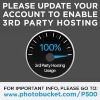Scoped rifles
Cheekweld, body position, sight picture, trigger control.
With an unloaded, safe rifle, sit down at the bench on the range, (or somewhere you can see at least 200 yards. (I'm presuming that the scope is mounted correctly and the rifle zeroed.) Put the rifle on a rest without the rest touching the barrel.
Make sure the scope is focused at the target distance, if it has a focus.
Use different head positions until you find the proper eye relief (Distance from the scope to the eye). At the proper eye relief, you won't see a shadow or a circle around the image.
With your shooting/triggerfinger hand, grip the pistol grip and pull the rifle firmly into your shoulder.
Smear a cheekweld on the rifle, using ALL the skin and cheek available, from the BACK to the FRONT, arriving at the proper eye relief position. Rest the whole weight of your head on the cheekweld. On some rifles, (using iron sights), put your cheekbone on the back of your thumbjoint so that your head will ride the recoil instead of getting whacked by it. (M1A, Garand)
(Caution: many rifles have the scope mounted too high. With a high scope, you can't get enough cheekweld to position the head for proper eye relief. Add a cheekpiece.)
Use your non-shooting hand to support the rifle at toe of the buttstock. Don't waste it holding the rifle up front- the rest certainly has it under control. Make a fist around the rear sling swivel and use it to control elevation against the tabletop or hold the rifle butt near your armpit.
Focus your eye on the crosshairs, not the target.
Move the front rest and your body until the crosshairs are centered on the target. Establish a natural point of aim so that the rifle isn't being muscled to the target.
Breathe deeply in and out and watch the crosshairs move up and down.
At the bottom of the respiratory cycle (at the respiratory pause) smoothly press the trigger straight back. When the rifle goes off, hold the trigger all the way to the rear all the way through the recoil.
Call the shot. Think of where the crosshairs were when the rifle went off.
Shooting accurately is more about technique than equipment. So far this year, (besides lots of highpower rifle competion) I have shot two deer. One was an offhand 70+ yard shot at a standing deer with a 1903A3 and open sights. When she broke from cover I took a natural point of aim at the first open spot I thought she might stop and look. She did. I broke the shot with good technique. The second deer was shot off the edge of a blind tower window with a P17 Eddystone at 100+ yards. I had to be quick: just rotated the chair around, pulled the rifle in, cheekwelded, focused on the front sight and broke the trigger smoothly straight back. The rifle went off and came down on a deer toppling over in her tracks.




